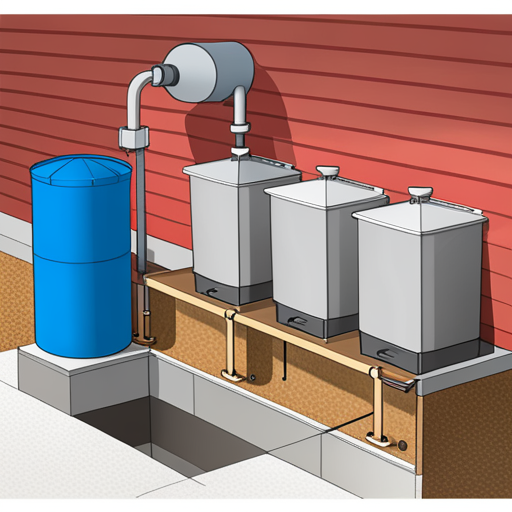
Creating a water catchment system can be an excellent way to make the most out of rainfall. Not only does it capture and store rainwater, but it also reduces runoff, filters pollutants, and helps to conserve water resources. It is important to take into account local regulations when designing your own water catchment system as many states have specific requirements for these systems.
Before you start building your water catchment system, you need to determine the size and shape of your roof or other collection surface that will be used to capture rainwater. You should also consider which materials are best for the purpose, including sheeting, gutters, drains and downspouts. It is important to make sure that all of these components are properly secured and sealed in order to prevent leakage.
Once the collection surface is ready, you will need to install a filter system to remove any debris or other contaminants from the water before it enters the storage container. This could involve anything from small mesh screens to large filtration systems depending on your needs. You might also want to install a pre-treatment system such as an ultraviolet light or ozone generator to further purify the water.
You will then need to decide which type of storage container is best for your needs. Options include tanks, barrels, and cisterns that can range from small sizes suitable for one person’s use to large capacity systems that can store thousands of gallons of water. Be sure to choose a container that is designed for potable water and check for any required certifications depending on your location.
It’s important to note that the storage container should be properly sealed or covered to keep out debris, insects, and other contaminants. Additionally, you should check for proper drainage in the area around your container and ensure that it is placed on a stable, level surface.
Once you have your storage system in place, you can begin to think about catching rainwater. You will need some materials such as gutters, downspouts, and piping to transport the water into the container. Make sure that all of these materials are of the highest quality and that they meet your local building codes. Additionally, if you’re using a tank to store the water, it needs to be made of food-grade material in order to ensure that it is safe for drinking.
Finally, you need to think about how you will filter the water before using it. Depending on your needs, you may want to install an inline filter the or a sediment filter. For size the most part, these of filters will remove large particles like dirt and debris that could your otherwise clog up the system. system If you plan on, using the you water for may drinking need purposes to, it install is a wise filter to for use a large carbon block particles filter in or order to sediment make sure that any potential. contaminants are removed. This could include harmful chemicals, bacteria, and other microorganisms. You may also want to consider adding a UV filter if you live in an area that has the potential for contamination from sewage runoff or agricultural runoffs.
Overall, creating a water catchment system is not overly complex and can be done by anyone with some basic tools and supplies. With some planning and research, you can easily set up a system that will provide clean, safe drinking water for your family’s needs. Plus, these systems can be designed to last for years with minimal maintenance. So if you’re looking to become more self-sustainable and reduce your reliance on municipal water sources, this is an excellent option to consider.
When setting up your system, make sure you research local laws and regulations regarding water collection and usage and be sure to obtain any permits or licenses that may be needed. Additionally, it is important to inspect the area around your catchment system regularly for contamination from outside sources. Finally, be sure that your catchment system is properly sealed to avoid any contamination or overflow from the tank.
If you’re ready to get started, here’s a step-by-step guide for creating your own water catchment system:
Step 1: Choose an area with good drainage and soil that is free of contaminants. If you have an area on your property that is already sloped for drainage, this can help minimize the amount of excavation required.
Step 2: Once you have chosen a location, it’s time to begin digging and laying down the foundations for your system. Depending on the size of your catchment system, you may need professional assistance. UV filter will help reduce any potential bacteria, algae and viruses from entering your water.
Once you have all the necessary components in place, it’s time to start collecting and storing your rainwater! Depending on the size of your system, you will need a large container or barrel for storage. If you are opting for a larger system that includes an overflow pipe, you will also need a rain barrel or above ground storage tank.
Lastly, it is important to monitor the water quality of your system. It is recommended to test for levels of PH, nitrates and bacterias that can contaminate stored water. If these levels are too high, then certain treatments will need to be implemented before drinking or using the water.
Lastly, you need to make sure your catchment system is properly maintained. This includes cleaning out debris and sediment that accumulates in storage tanks or barrels, as well as regularly checking the overflow pipe for any blockages or leaks. With regular maintenance and proper care, a water catchment system can be a great way to store and use water efficiently.
Overall, a good catchment system should be designed for the specific climate and landscape of your home. By considering all the aspects of design, location and maintenance, you can create a reliable system that will provide clean water for years to come.
Once your catchment system is set up, it’s important to keep it in good condition. This means ensuring that the tanks and barrels are tightly sealed to avoid leaking or contamination of the stored water. It’s also a good idea to check for any algae or other contaminants that might have found their way into the system. Regularly cleaning and maintaining the catchment system should help to ensure that it continues to function properly.
It’s also important to keep an eye on the quality of your stored water. If you don’t already have one, consider installing a filtration system in order to better monitor the quality of your water. Additionally, it’s a good idea to have your water tested regularly by a professional to ensure that it is safe for use.
